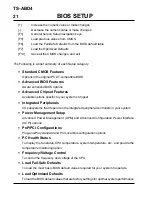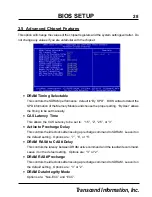
BIOS SETUP
26
•
CPU L1/L2 Cache
Select “Enabled” to start the CPU function for L1/L2 Cache.
•
CPU Fast-Strings
Select “Enabled” to start the CPU Fast-String.
•
Quick Power On Self Test
Select “Enabled” to reduce the amount of time required to run POST. The Quick POST
skips certain steps. We recommend that you normally disable Quick POST. It is better
to find a problem during POST than to lose data during your work.
•
ATA/100 & SCSI Boot Order
Options are: “SCSI, RAID” or “RAID, SCSI”.
•
First/Second/Third/Other Boot Device
The original IBM PCs loaded the DOS operating system from drive A (floppy disk). IBM
PC-compatible systems therefore search for an operating system first on drive A and
then on drive C (hard disk). However, BIOS attempts to load the operating system from
the devices in the sequence selected in this field. In addition to drives A (“Floppy”) and
C (“HDD-0”), options include: “LS120”, a “SCSI” bootable drive, “CDROM”, “HDD-1”,
“HDD-2”, “HDD-3”, a “ZIP100” drive, and a “LAN” drive. If your boot device is not in the
list, set “Boot Other Device” to “Enabled” to let the system detect the drive automatically.
•
Swap Floppy Drive
This field is effective only in systems with two floppy drives. Selecting “Enabled” assigns
physical drive B to logical drive A, and physical drive A to logical drive B. This item is
useless in OS/2.
•
Boot Up Floppy Seek
When you select “Enabled”, the BIOS tests (seeks) floppy drives to determine whether
they have 40 or 80 tracks. Only 360-KB floppy drives have 40 tracks; drives with 720KB,
1.2MB, and 1.44MB capacity all have 80 tracks. Because very few modern PCs have
40-track floppy drives, we recommend that you set this field to “Disabled” to save time.
•
Boot Up NumLock Status
Toggle between “On” and “Off” to control the state of the NumLock key when the system
boots. When toggled “On”, the numeric keypad area of the keyboard generates numbers
instead of controlling cursor operations.
Transcend Information, Inc.














































